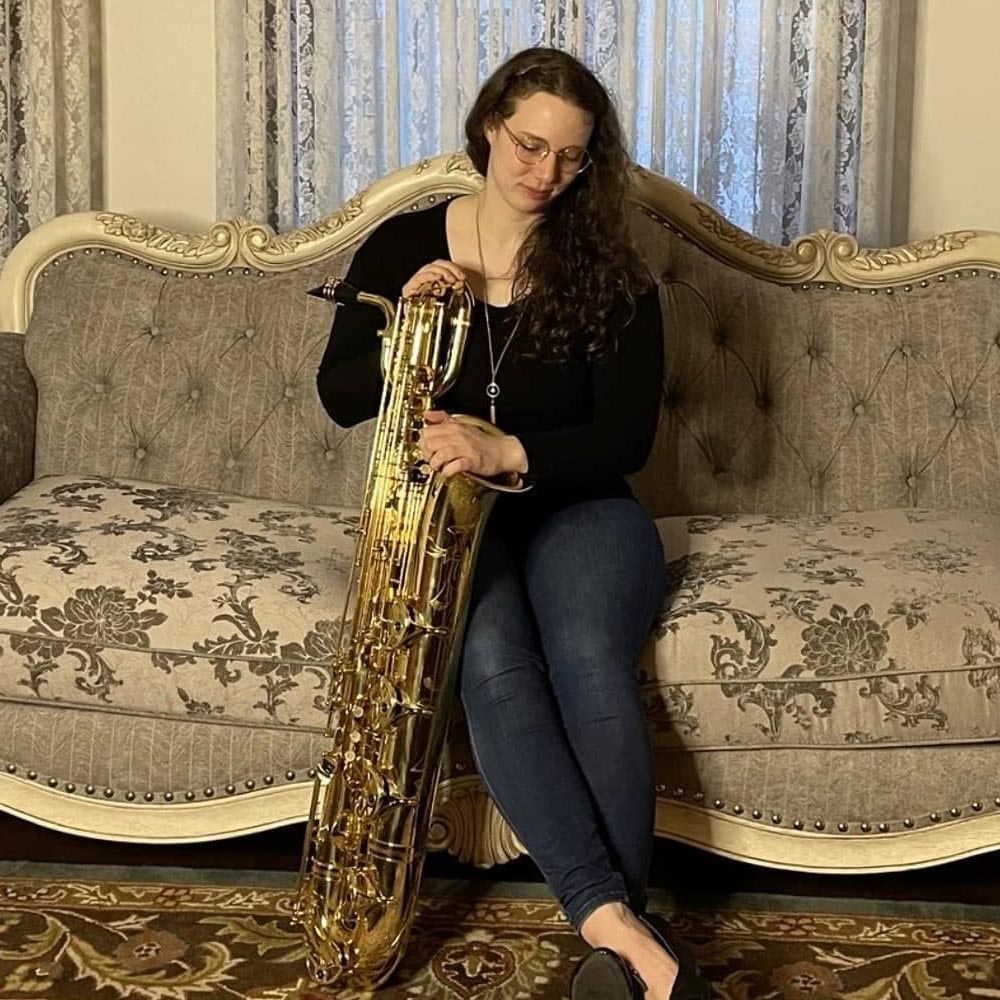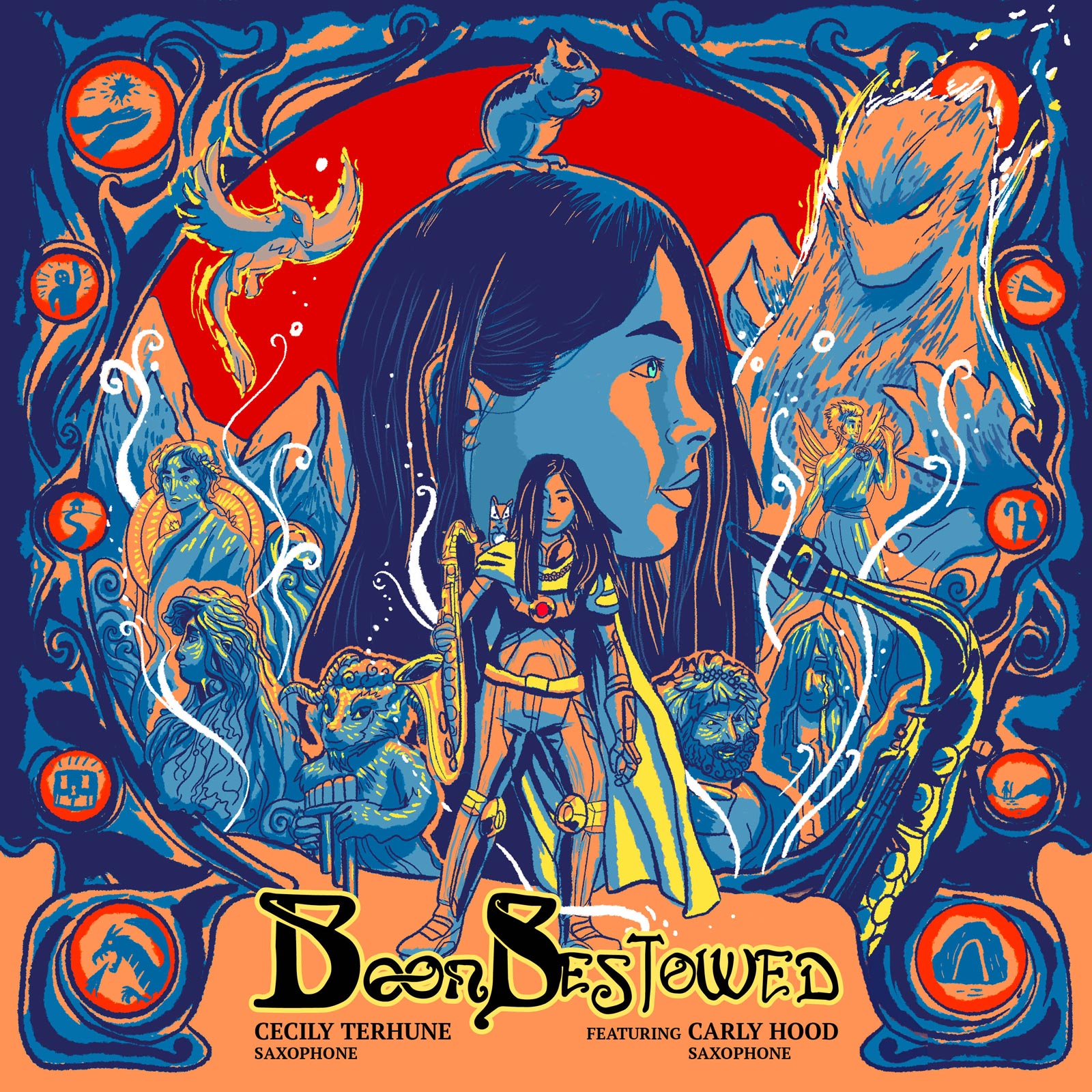Boon Bestowed
Cecily Terhune saxophone
Carly Hood saxophone
Indianapolis saxophonist Cecily Terhune dives headfirst into an exploration of heroism on her genre-defying debut album BOON BESTOWED. Harnessing the principles laid out in Joseph Campbell’s seminal theory of mythology, Terhune creates a captivating, musical microcosm in which the listener is invited to take center stage as the audacious protagonist.
The theory goes as follows: Most myths in human history have an archetypal heroine/hero who answers a call to journey through a supernatural world. After undergoing a transformation of strength and character, the heroine returns equipped with material and/or incorporeal boons to bestow upon her community. Marveling at the highly diverse and exquisite mastery of the saxophone on BOON BESTOWED, one is apt to wonder what supernatural landscapes Terhune might have traversed herself.
Listen
Stream/Buy
Choose your platform
Track Listing & Credits
| # | Title | Composer | Performer | |
|---|---|---|---|---|
| 01 | La Dernière Nuit | David Salleras | Cecily Terhune, alto saxophone; Carly Hood, baritone saxophone | 8:09 |
| 02 | Zippy! | Gregory Wanamaker | Carly Hood, soprano saxophone; Cecily Terhune, alto saxophone | 4:03 |
| 03 | Six Riffs After Ovid: Maceo Parker (Pan) | Michael Daugherty | Cecily Terhune, soprano saxophone | 1:42 |
| 04 | Six Riffs After Ovid: Buddy Holly (Phaeton) | Michael Daugherty | Cecily Terhune, soprano saxophone | 2:03 |
| 05 | Six Riffs After Ovid: Joni Mitchell (Niobe) | Michael Daugherty | Cecily Terhune, soprano saxophone | 2:47 |
| 06 | Six Riffs After Ovid: Jim Morrison (Bacchus) | Michael Daugherty | Cecily Terhune, soprano saxophone | 1:33 |
| 07 | Six Riffs After Ovid: Prince (Narcissus) | Michael Daugherty | Cecily Terhune, soprano saxophone | 1:51 |
| 08 | Six Riffs After Ovid: Aretha Franklin (Arethusa) | Michael Daugherty | Cecily Terhune, soprano saxophone | 2:43 |
| 09 | Peppercorn Suite: Black | Jim Rhinehart | Cecily Terhune, soprano & tenor saxophones; Carly Hood, alto, soprano & baritone saxophones | 1:38 |
| 10 | Peppercorn Suite: Pink | Jim Rhinehart | Cecily Terhune, soprano & tenor saxophones; Carly Hood, alto, soprano & baritone saxophones | 2:31 |
| 11 | Peppercorn Suite: Green | Jim Rhinehart | Cecily Terhune, soprano & tenor saxophones; Carly Hood, alto, soprano & baritone saxophones | 1:58 |
| 12 | Peppercorn Suite: White | Jim Rhinehart | Cecily Terhune, soprano & tenor saxophones; Carly Hood, alto, soprano & baritone saxophones | 2:05 |
| 13 | Frost: Erik Prelude | Marc Mellits | Cecily Terhune, soprano saxophone | 2:41 |
| 14 | Frost: Annika | Marc Mellits | Cecily Terhune, soprano saxophone | 3:39 |
| 15 | Frost: Karl | Marc Mellits | Cecily Terhune, soprano saxophone | 1:49 |
| 16 | Frost: Adrienne | Marc Mellits | Cecily Terhune, soprano saxophone | 2:46 |
| 17 | Frost: Erik Postlude | Marc Mellits | Cecily Terhune, soprano saxophone | 1:51 |
| 18 | Flight Mode | Rachel Stott | Cecily Terhune, soprano saxophone | 4:16 |
| 19 | Boon Bestowed: Sir Joan - Possibility | Katie Madonna Lee, Cecily Terhune | Cecily Terhune, soprano, baritone, alto & tenor saxophones | 3:39 |
| 20 | Boon Bestowed: Malala - Knowledge | Katie Madonna Lee, Cecily Terhune | Cecily Terhune, soprano, baritone, alto & tenor saxophones | 1:58 |
| 21 | Boon Bestowed: The Madonna - Life | Katie Madonna Lee, Cecily Terhune | Cecily Terhune, soprano, baritone, alto & tenor saxophones | 2:46 |
| 22 | Boon Bestowed: Queen M.P. Johnson - Justice | Katie Madonna Lee, Cecily Terhune | Cecily Terhune, soprano, baritone, alto & tenor saxophones | 2:34 |
Recorded July 6, 7, 22, 23, 2023
Session Producer Evan Gidley (tracks 1-2, 9-12)
Session Producer Carly Hood (tracks 3-8, 13-22)
Recording Session Engineer, Mixing Christoph Thompson
Mastering Melanie Montgomery
Executive Producer Bob Lord
VP of A&R Brandon MacNeil
A&R Chris Robinson
VP of ProductionJan Košulič
Audio Director Lucas Paquette
VP, Design & Marketing Brett Picknell
Art Director Ryan Harrison
Design Edward A. Fleming
Publicity Kacie Brown
Artist Information

Cecily Terhune
Described as “spirited and intellectual,” Indianapolis-based musician Cecily Terhune enjoys a rewarding career as a performer, recording artist, and educator. She concertizes regularly as a soloist and proud member of funk-fusion septet Audiodacity and the Hood/Terhune Duo, among other groups. When not on stage, Terhune shares her passion for music by teaching private students and sectionals at Carmel and Noblesville High Schools, serving as a member of the Committee for Gender Equity in the North American Saxophone Alliance, and maintaining her educational YouTube channel.

Carly Hood
Carly Hood is a saxophonist and music educator based in the Cincinnati metropolitan area. She is an active performer in both solo and chamber capacities. Carly has been a featured concerto soloist with the CCM Concert Orchestra, Stephen F. Austin Orchestra of the Pines, and Cincinnati Youth Wind Ensemble, most recently performing Roshanne Etezady’s new saxophone concerto Negative Split. As an orchestral saxophonist, Carly has performed with several orchestras across the region, including the Columbus Symphony Orchestra, Louisville Orchestra, Lexington Philharmonic, Springfield Symphony Orchestra, and Kentucky Symphony Orchestra. In addition to her work as a classical saxophonist, Hood plays saxophone with the German group The Überland Band, which performs across the eastern United States.
Notes
To celebrate and expand the repertoire for solo and duo contemporary classical saxophone, I humbly offer my debut album BOON BESTOWED. This project contains a collection of simultaneously challenging and approachable works selected to compel diverse audiences.
BOON BESTOWED is designed to take the listener on a journey that loosely outlines the arc of Joseph Campbell’s monomyth. Campbell (1904-1987) was an American writer, professor, and mythologist whose book, The Hero with a Thousand Faces, has furthered our collective understanding of the structure of stories throughout human existence. Upon comparing copious historical epics, Campbell distilled a standard plot into three main parts with various subcategories: the departure, initiation, and return. He dubbed this structure, “the hero’s journey.”
The BOON BESTOWED listener is encouraged to create their own narrative while experiencing this work. In my mind, the programmatic music of this album paints a fantastical Odyssey-like epic. For my narrative, I envision a confident, driven heroine guided by other-worldly spirits embarking on an adventurous journey with her chipmunk companion, a string of peppercorns, and a winged beast.
For the music, I chose to feature solo and duo pieces in order to explore the saxophones’ natural color palettes. For most of this project’s solo works, I selected the beguiling soprano saxophone as my voice, though all four horns are included in the title track, Boon Bestowed. The duet pieces offer variety and the opportunity to experiment with some different saxophone combinations: alto/baritone, soprano/alto, soprano/soprano, alto/tenor, and tenor/baritone.
This project’s style embodies the oxymoron, “contemporary classical.” While the music is composed in the classical idiom, the project’s novelty defies the standard meaning of the word “classical.” The contemporary nature of the project is evident with the fact that the oldest pieces in the collection were written in 2011. While these compositions generally fit within the classical idiom, some of them also hint at minimalist, jazz, progressive rock, blues, and funk influences.
Thank you to my family and friends and colleagues for all their guidance and assistance! I would like to thank (in no particular order): Carly Hood, Christoph Thompson, Evan Gidley, Terri McConahay, John Terhune, Lucy Terhune, Annie Terhune, Rocky Rodriguez, Mark Buselli, Laura Haines, George Wolfe, James Bunte, Jay Young, Heidi Radtke, Nicki Roman, Eric Salazar, Jalissa Gascho, Brian Bosley, Kelsey Georgesen, my Audiodacity family, the attendants of my April 2022 recital, the Indiana Arts Commission, the Center for the Performing Arts, PARMA Recordings, and all others who have supported me in big and small ways. I feel much love from my community and I love you all in return.
— Cecily Terhune

